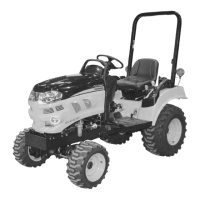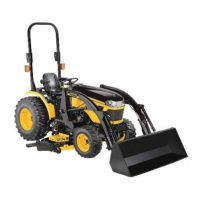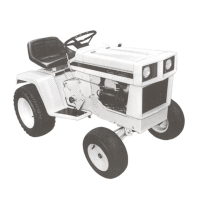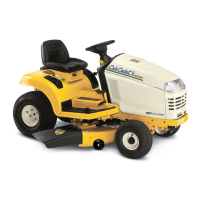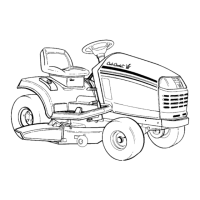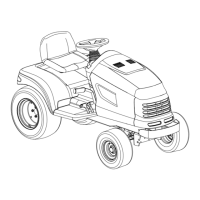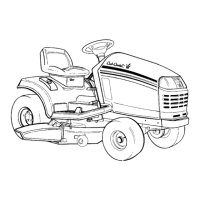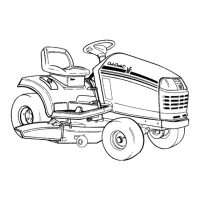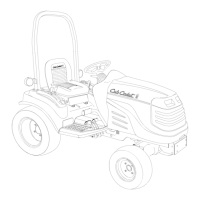
Do you have a question about the Cub Cadet Sc2400 and is the answer not in the manual?
Welcomes the user to the tractor and highlights the importance of the operator's manual for long-term service.
Explains the purpose of the operator's manual and the importance of studying its content for safe operation.
Details the meaning and importance of safety-alert symbols used throughout the manual for hazard awareness.
Provides essential safety guidelines and checks to perform before operating the tractor.
Outlines critical safety measures for starting the engine and operating the tractor correctly.
Offers safety advice for operating the tractor, including checks, turns, and awareness of surroundings.
Provides guidelines for ensuring children's safety around the operating tractor and work area.
Details critical safety procedures and warnings for operating the tractor on slopes and uneven terrain.
Specifies safety precautions and regulations for driving the tractor on public roads.
Provides instructions on how to safely park the tractor, including precautions for slopes.
Outlines critical safety measures to follow when performing maintenance or servicing on the tractor.
Explains the meaning and importance of various safety decals found on the tractor.
Presents detailed technical specifications for the tractor model, including engine, dimensions, and capacities.
Lists the reference traveling speeds for the tractor based on range gear lever positions.
Provides an overall visual identification of the tractor's main external components with numbered labels.
Identifies and explains the function of various controls located in the operator's station.
Details the specific functions of individual components, including switches and levers.
Explains the instrument panel gauges, warning lights, and various switches and control levers.
Lists essential checks to perform on the tractor before starting operation.
Details regular checks for safety features, tires, fuel, fluids, and debris.
Provides a step-by-step guide on how to safely start the tractor engine.
Details the correct procedure for safely shutting down the tractor engine.
Explains the steps to restart the engine if it stalls during operation.
Provides guidelines for the break-in period of a new tractor to ensure longevity and performance.
Covers essential steps for operating the tractor, including using controls and ensuring safety.
Details the procedure for stopping the tractor normally and in emergency situations.
Explains how to monitor instrument panel indicators and warning lights while driving.
Outlines the correct procedure for safely applying the parking brake and parking the tractor.
Provides critical safety instructions for operating the tractor on public roads.
Details safety precautions and operational guidance for slopes and rough terrain.
Covers safety precautions and procedures for operating the Power Take Off (PTO).
Provides instructions and warnings for correctly installing implements onto PTO drivelines.
Explains how to use the reverse override function to operate the PTO while reversing.
Details safety precautions and component identification for the 3-point hitch system.
Describes how to service and adjust the right lift link of the 3-point hitch.
Explains the function and adjustment of the top link for implement posture.
Details the adjustment procedure for the sway links to control implement lateral movement.
Provides warnings and limitations regarding towing with the hitch system.
Explains the operation of the 3-point hitch control lever for raising and lowering implements.
Covers the use of the optional implement control valve and its components like quick couplers.
Provides safety warnings and guidelines related to tire maintenance, inflation, and mounting.
Details information on front and rear ballast options to improve tractor stability and traction.
Presents a comprehensive checklist of maintenance tasks and their recommended service intervals.
Lists the types and capacities of lubricants required for various tractor components.
Advises on using authentic parts and obtaining technical documentation from the dealer.
Outlines essential daily checks to ensure the tractor is safe and ready for operation.
Provides instructions on how to check and maintain the engine oil level.
Details the procedure for checking the transmission and hydraulic oil levels.
Explains how to check the tractor's safety interlock systems for proper function.
Guides on inspecting and adjusting the tractor's brake system.
Specifies the procedure and torque for checking wheel bolt tightness.
Provides instructions for checking hydraulic hoses for leaks and damage.
Details initial maintenance tasks required after the first 50 hours of operation.
Outlines maintenance tasks to be performed every 100 hours of operation.
Details maintenance tasks required every 200 hours of operation.
Specifies maintenance tasks to be performed every 300 hours of operation.
Outlines maintenance tasks required every 500 hours of operation.
Details maintenance tasks to be performed every 1000 hours of operation.
Lists maintenance tasks to be performed annually.
Specifies maintenance tasks to be performed every two years.
Covers safety notes, inspection, removal, installation, and cleaning of the tractor battery.
Details the procedure for replacing accessory fuses and checking alternator/main fuses.
Provides instructions for replacing headlight, work light, tail light, and turn signal bulbs.
Outlines general safety precautions for storing the tractor, emphasizing fuel and engine safety.
Details the steps for preparing the fuel system and engine for long-term storage.
Provides a checklist for getting the tractor ready for operation after storage.
Covers common engine starting issues, running problems, exhaust issues, and overheating.
Addresses troubleshooting for machine vibrations, starting issues, and operational failures.
Troubleshoots issues related to brake functionality, pedal play, and linkage.
Covers troubleshooting for steering issues including tire pressure, lubrication, and axle condition.
